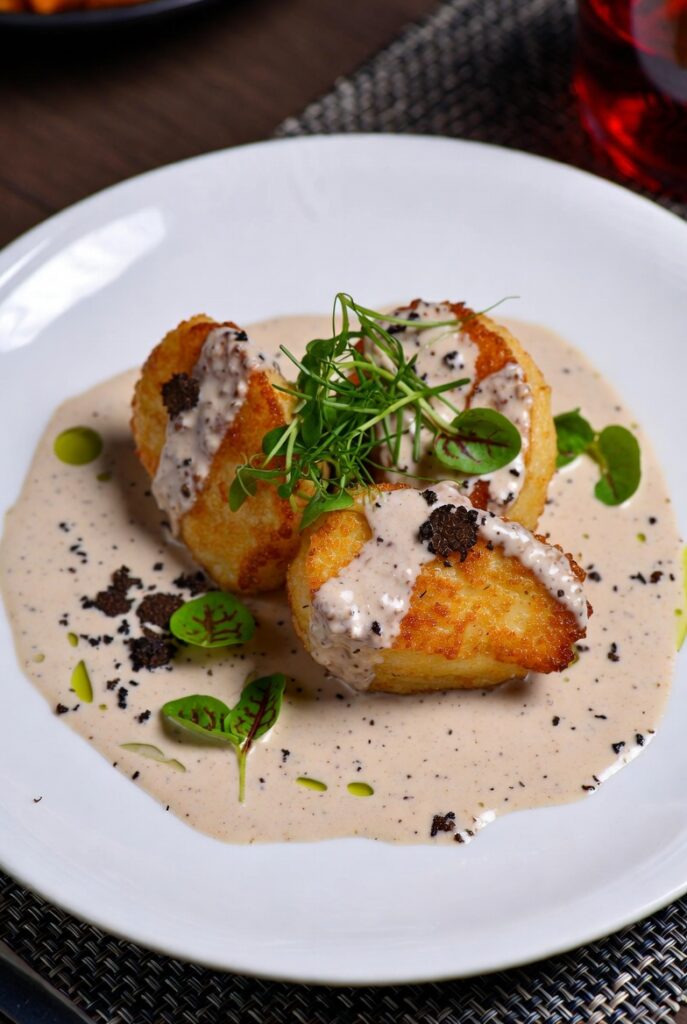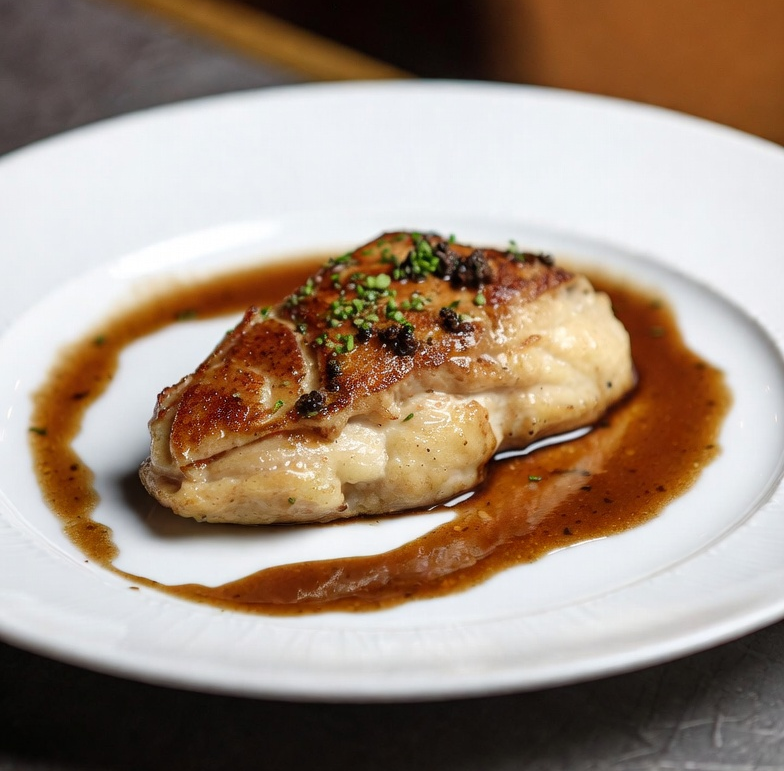🥩 Sweetbreads: The Chef’s Secret Luxury — A Complete Culinary Guide

Introduction: The Hidden Gem of the Butcher’s Block
Among the most exquisite ingredients in classical and modern cuisine — caviar, foie gras, truffles — there exists a delicacy that quietly captures the admiration of true chefs: sweetbreads.
Despite their name, sweetbreads are neither sweet nor bread. They are tender, creamy glands found in young animals, prized for their delicate flavor and buttery texture. Once reserved for fine French tables, sweetbreads are making a comeback in modern gastronomy, celebrated by Michelin-starred chefs and adventurous diners alike.
Chef’s Note: Sweetbreads reward careful hands and patient technique. Treat them gently, and they will reward you with one of the most luxurious bites in the culinary world.
1. What Exactly Are Sweetbreads?
Sweetbreads are the thymus glands (and sometimes the pancreas) of young animals, especially veal calves and lambs. These glands are vital early in life for immunity and digestion, but they shrink as the animal matures — which is why adult animals no longer produce usable sweetbreads.
Two anatomical types are recognized:
- Thymus Sweetbread: Located in the neck and chest; plump, oval, and smooth.
- Pancreas Sweetbread: Found near the stomach; flatter and more lobed.
Because they come only from young animals, they are rare and highly prized.
2. The Curious Name: “Sweet” and “Bread”
The term sweetbread dates back to 16th-century English.
- “Sweet” describes their mild, pleasant flavor compared to stronger organ meats.
- “Bread” comes from the Old English brede, meaning “flesh” or “meat.”
So historically, “sweetbread” simply meant “sweet meat” — a name that survives today even as its meaning confuses many diners.
3. Butchery Insights: Where They Come From
From a butcher’s perspective, sweetbreads are part of white offal — pale, tender organs such as brain, tripe, or tongue. They are delicate, highly perishable, and must be handled with great care.
- Weight per animal: 100–300 g (veal), 50–150 g (lamb)
- Color: creamy white to light pink
- Texture: soft, smooth, slightly spongy when raw
Butcher’s Tip: Sweetbreads spoil faster than muscle meat. Always chill immediately after slaughter and cook within 24–48 hours.

4. Types of Sweetbreads by Animal
| Animal | Gland Type | Texture | Flavor | Common Use |
|---|---|---|---|---|
| Veal (Calf) | Thymus & Pancreas | Creamy, delicate | Buttery, mild | French haute cuisine |
| Lamb | Thymus | Slightly firm | Sweet, grassy | Mediterranean dishes |
| Goat Kid | Thymus | Tender yet gamey | Earthy | Rustic regional fare |
| Piglet | Pancreas | Fatty, rich | Savory | Spanish & modern fusion |
| Deer Fawn | Thymus | Fine-grained | Mild wild aroma | Seasonal gourmet menus |
Veal sweetbreads remain the gold standard, particularly in French gastronomy.
5. Preparing Sweetbreads: The Classic Chef’s Technique
Sweetbreads require meticulous cleaning and preparation before cooking. Here’s how professional kitchens do it:
Step 1 – Soaking
Soak in cold water, lightly salted or with a splash of milk, for 6–12 hours. This removes blood and impurities.
Step 2 – Blanching
Place in simmering salted water for 2–5 minutes, then shock in ice water. This firms the texture and loosens the outer membrane.
Step 3 – Peeling
Gently remove the thin membrane and connective tissue by hand. Precision is key — damage the gland and it loses its structure.
Step 4 – Pressing
Press between two trays with a light weight for 1–2 hours. This ensures an even thickness and smoother texture.
Step 5 – Cooking
Once cleaned and pressed, they can be sautéed, roasted, grilled, or fried.
Chef’s Note: Perfect sweetbreads are crisp on the outside and silky inside — like a savory custard sealed in a golden shell.
6. Classical Cooking Methods
| Method | Technique | Texture Outcome | Example Dish |
|---|---|---|---|
| Poached & Glazed | Gently cooked in stock, finished with sauce | Soft and juicy | Ris de veau glacé au Madère |
| Sautéed | Floured and browned in butter | Crisp outside, creamy inside | Sweetbreads with Morel Mushrooms |
| Grilled | High heat, charred edges | Smoky, firm | Argentine Mollejas a la Parrilla |
| Deep-fried | Breaded or battered | Crispy bite | Modern Tapas Sweetbreads |
7. Flavor Profile and Pairings
Sweetbreads have an unmatched combination of creaminess and mild sweetness. Their subtlety allows them to carry other flavors beautifully.
Flavor descriptors: buttery | nutty | mild | clean | savory-sweet
Best companions:
- Acidity — lemon, vinegar, white wine
- Earthiness — mushrooms, truffles, celeriac
- Herbs — thyme, tarragon, sage
- Textural contrast — crisp greens or roasted roots
- Wines — Champagne, Chardonnay, or aged Sherry
Pairing Idea: Pan-seared veal sweetbreads with morels, baby leeks, and a drizzle of truffle jus — paired with a buttery Burgundy.
8. Sweetbreads Around the World
🇫🇷 France
The French ris de veau defines luxury dining. Classic versions include:
- Ris de veau aux morilles — with morel mushrooms and cream
- Ris de veau à la financière — with Madeira, truffle, and cockscomb garnish
- Tournedos Rossini — beef tenderloin topped with foie gras and sweetbread medallion
🇮🇹 Italy
Known as animelle, Italian chefs prepare them simply:
- Animelle alla Milanese — breaded and fried
- Animelle al limone — sautéed with lemon and capers
🇪🇸 Spain & Latin America
In Argentina and Uruguay, mollejas are grilled over charcoal — smoky outside, creamy inside. They are a staple of the asado.
🇬🇷 Greece & Middle East
Sweetbreads appear in kokoretsi and other mixed offal rolls, seasoned with oregano and lemon.
🇬🇧 United Kingdom
Once common in pies and puddings; now reappearing in modern gastropubs.
🇺🇸 Modern America
Contemporary chefs such as Thomas Keller and Daniel Boulud reintroduce sweetbreads in tasting menus — seared, glazed, or paired with foie gras.
9. Modern Culinary Innovations
Chefs today reinterpret sweetbreads through modernist and global lenses:
- Sous-vide sweetbreads finished with herb butter.
- Asian glazes — soy, mirin, and ginger caramel.
- Street-style bites — crispy sliders or tacos with chili-lime butter.
- Vegetarian mimicry — cauliflower “sweetbreads” for ethical menus.
Trend Watch: As diners rediscover nose-to-tail cooking, sweetbreads symbolize refined sustainability — using the whole animal, beautifully.
10. Culinary Science and Perfect Texture
| Stage | Purpose | Result |
|---|---|---|
| Soak | Purge blood | Whiter, milder flavor |
| Blanch | Firm tissue | Easier to handle |
| Press | Shape evenly | Uniform doneness |
| Sear | Caramelize surface | Flavor & texture contrast |
| Rest | Relax proteins | Juicy interior |
Tip: Never overcook — beyond medium, sweetbreads turn chalky. Always finish cooking with butter basting for flavor and sheen.
11. Butchery & Storage Knowledge
- Freshness is critical: purchase from reputable butchers who handle veal or lamb daily.
- Storage: keep at ≤ 4 °C, use within 2 days.
- Blanched for prep: can be vacuum-sealed and frozen up to 3 months.
- Yield: one calf provides only two small lobes — rarity explains price.
12. Nutritional Value
While rich and indulgent, sweetbreads are also nutrient-dense.
| Nutrient | per 100 g | Benefit |
|---|---|---|
| Protein | 17 g | Builds tissue |
| Fat | 13 g | Source of flavor, energy |
| Vitamin B12 | High | Supports nerves |
| Zinc | High | Immune function |
| Selenium | Moderate | Antioxidant |
Enjoyed occasionally, sweetbreads can fit into a balanced gourmet diet.
13. Serving and Presentation Styles
Fine Dining
- On celeriac purée with truffle jus
- Layered with foie gras and apple confit
- Garnished with edible flowers or micro-herbs
Bistro or Brasserie
- Golden sweetbread medallions with lemon-caper butter
- Served over potato gratin or sautéed spinach
Street or Casual
- Crispy sweetbread tacos with lime crema
- Sweetbread sliders with mustard aioli
Banquet
- Carved slices in a chafing dish, glazed in white-wine mushroom sauce
14. Culinary Substitutes and Comparisons
| Ingredient | Similarity | Use Tip |
|---|---|---|
| Foie gras | Equal richness, softer | Alternate luxury offal |
| Chicken liver | Stronger flavor | Budget alternative |
| Calf brain | Creamy texture | Handle gently |
| Scallops (texture analogy) | Non-offal option | Vegetarian mimicry |
15. Market and Economic Aspects
Sweetbreads are among the most expensive offal cuts, often fetching $25–45 per lb in specialty markets.
Their cost reflects both rarity and labor — each gland must be hand-trimmed and cleaned.
In restaurant menus, they appear as chef’s specials or market-price entrées due to seasonal availability. Specialty veal farms in France, the Netherlands, and the U.S. supply premium exports worldwide.
16. Ethics and Sustainability
Modern chefs embrace the nose-to-tail philosophy — using every edible part of the animal to minimize waste. Ethically sourced sweetbreads come from farms practicing:
- Humane rearing and slaughter
- Transparent supply chains
- Whole-carcass utilization
This approach balances luxury with responsibility — transforming a by-product into a gourmet treasure.
17. Cultural Symbolism and Revival
For centuries, sweetbreads symbolized culinary refinement. In old French apprenticeships, mastering them proved a cook’s precision.
In today’s food culture, they represent respect for tradition and innovation through rediscovery. From classic Parisian brasseries to avant-garde tasting menus, sweetbreads embody the chef’s devotion to texture, flavor, and craft.
Conclusion: The Delicate Art of Sweetbreads
Sweetbreads are more than offal; they are a test of skill, patience, and respect for the animal.
To prepare them is to walk the line between luxury and simplicity — transforming a modest gland into a sublime dining experience.
Their taste lingers not just on the palate but in culinary memory: buttery, tender, faintly sweet — a reminder that true gastronomy values every part of the animal, treated with artistry and care.
Final Thought: Whether gently poached in cream or seared golden in butter, sweetbreads stand as proof that the world’s finest foods are born not of excess, but of craftsmanship.
Expand Your Reading
Discover more content you might enjoy
